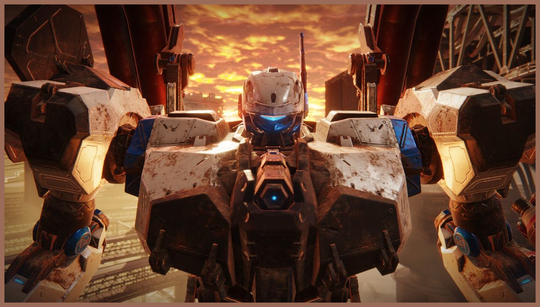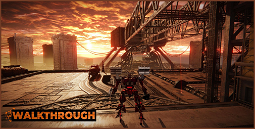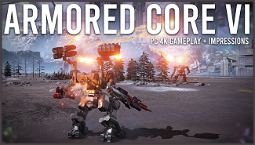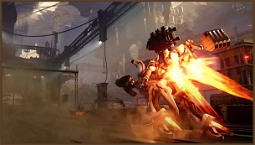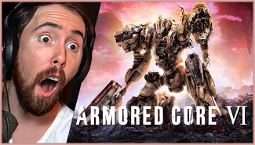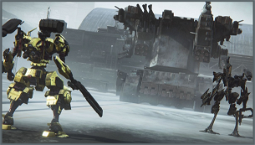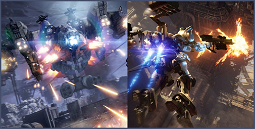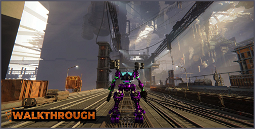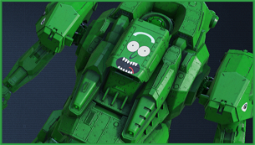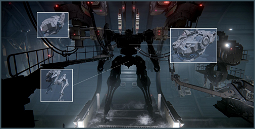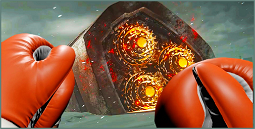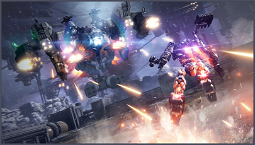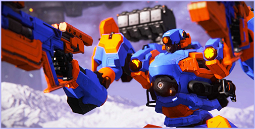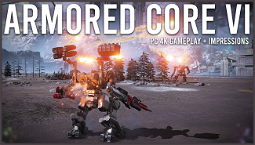Armored Core 6: Fires of Rubicon
If you’re searching for something a little different, Armored Core 6: Fires of Rubicon is what you’re looking for. The gameplay strikes a satisfying balance between being challenging while still allowing you to experiment, and the missions are over in a flash – literally. Each one is over in ten minutes, and if you die, you can just retry without losing progress. In other words, you can feel like you’re a powerful mech pilot with all the best parts, and then jump right back into the action.
The missions themselves are short, sharp, and to the point. They’re also over in ten minutes. Sometimes, you’re defending an area from waves of incoming enemies, sometimes you’re escorting a convoy, and sometimes you’re clearing out a building. There’s a lot of intense battling or combat encounters, but that’s it.
It’s a refreshing departure from the classic RPG formula, and one that I find myself more and more enamoured with as I get older. With no time to get lost or sidetracked, the missions are focused and intense, and allow you to create your own stories and strategies. You’ll get to grips with the controls while you’re waiting for the elevator, and then you’ll be in the thick of it as soon as you step out. And then you’ll be done, and back to the shop to buy new parts, ready for the next one.
That shop is where the nostalgia really kicks in. I spent a lot of time in shops like this playing the original Armored Core way back on the PlayStation, piecing together my mech and buying new weapons. The shop in Fires of Rubicon has a lot more options than those in the PlayStation games, but it’s the same sort of thing. Each mission sees you picking up credits, and you can use those to buy new parts or weapons ready for the next run. You can also sell parts you don’t want and buy new ones, allowing for more experimentation.
The other thing that strikes me about Fires of Rubicon is the sound and animation. The mechs themselves are impressive enough, but the sound effects – from the whirring of your engine, to the clang of a missile lock – and the animations really bring them to life. They’re fast and furious, with a satisfying slow-mo explosion effect accompanying each killing blow. I played on PC, and despite the frame rate hovering around 60 fps most of the time, I didn’t notice it much at all. It’s FromSoftware’s first PC game to support frame rates over 60, and I’m not sure I’d really want it any other way.
Armored Core 6 PC graphics
The graphics are a bit of a letdown, at least on a high-end setup. On my Titan RTX and Oculus Rift, the world is crisp and detailed, but it doesn’t look like anything else on the market right now. When everything else is offering up incredible levels of detail and draw distance, then, well, it just doesn’t look as stunning. On a high-resolution monitor, you’ll be able to appreciate the attention to detail on the mechs, but in-game it’s a little flat by comparison.
Still, it’s hard to find fault with the combat. The slower pace of combat compared to FromSoftware’s action RPGs means you’ll have a little more time to appreciate the surroundings. There’s not a great deal to interact with, though – you’ll see fields, buildings, and the odd enemy outpost, but you can’t really do much with them.
Armored Core 6 story
FromSoftware’s RPGs are famous for their sparse cutscenes and deep, rich lore, but Fires of Rubicon strikes a different balance. The Mecha fan service is in full effect here, with many parts designed to look like specific anime mechs and plenty of references to other games in the series. The sparse cutscenes add to that, but they’re also more explicit than FromSoftware’s RPGs – there’s none of that ‘let’s just pretend these characters are suddenly in this different world’ nonsense.
The leaders of Rubicon’s corporate mercenary squads provide regular voice messages to you throughout the campaign, and they’re a nice touch. They’re not really interactive, but they’re a bit of personality that you don’t get in the RPGs. They’re not essential, but they do serve to highlight the fact that you’re not alone out there.
That’s about it for interactivity – the environments themselves are stunning. Each mission takes you to a different area, from a tropical island to a snowy mountain base, and then a post-apocalypse city with a giant mech wrecking everything. Each is visually stunning, but there’s little to actually interact with – you can’t go off exploring, and the areas don’t change much throughout the game.
Armored Core 6 gameplay
The gameplay itself is similar to other FromSoftware games – you have a hover, a weapon, and a melee attack, along with a number of abilities such as a speed boost and a ‘dash’ which lets you maneuver around the battlefield quickly. The slow-mo mechanic is new, and each mech part offers a new ability – charge attacks, shell attacks, and more. The balance struck between being challenging and allowing you to experiment is what makes Fires of Rubicon so good. You’ll find yourself dying a lot – but you can always retry without losing progress.
At the same time, Armored Core 6 strikes a nice balance between being forgiving and providing detailed feedback. If you’re using a part that offers an area-of-effect attack, you’ll see red cones indicating where it’s going to land. If you’re over your enemy and you pull the trigger, you’ll hit them, but if you’re too far away, the indicator will turn grey. It’s helpful, but it’s not going to spoil your fun – if you’ve equipped your mech with a part that does a huge damage-dealing attack, you’ll hit your target if you get close enough, and the lack of feedback helps to keep things unpredictable.
Armored Core 6 multiplayer
The multiplayer is the one part of Fires of Rubicon that I haven’t had a chance to try yet, but Armored Core’s competitive format works well – you’ll earn parts, and then you’ll take your mech online and battle it out with other players.
